Laser Distance Measurer
Group Members
Arya Chowdhury, Liu Sijin, Jonathan Wong
Background and Theory
Experimental Work

2.1 Procedure
2.1.1 Laser Modulation and System Initialization
Configure the function generator (Tektronix AFG1022) to output a 10 MHz square wave with an amplitude of 0–3.1 V (High level: 3.1 V, Low level: 1.0 V, output impedance: 50 Ω) to modulate the laser diode. Use the Keithley 2231A-30-3 DC power supply to provide 5.0 V to the laser driver circuit, with a current limit of 30 mA. Verify the laser beam stability to avoid multimode noise or thermal drift that could distort the modulation waveform.
2.1.2 Optical Alignment and Target Illumination System
Mount the 650 nm laser diode and use a convex lens to collimate and focus the beam onto the reflective target surface. Fix the LED source and the Photodector on a linear translation stage, ensuring proper alignment for the beam return to the detector at all positions along the translation stage. The detector and the laser diode were mounted on a postholder so that the height of the detectors were adjustable.
2.1.3 Detection and Amplification Circuit Configuration
For the photodetector, a Hamamatsu S5971 silicon photodiode was used to detect the reflected light signal. To amplify the signal linearly without saturation, connect the detector output to a matched high-speed preamplifier (bandwidth >100 MHz, gain ~10³–10⁵). Connected the amplifier output to Channel 2 of a digital oscilloscope; connect the reference signal from the function generator to Channel 1 as the modulation phase reference.
2.1.4 Static Testing: Time Delay vs. Distance Mapping
Use the oscilloscope’s cursor measurement function to determine the relative time delay Δt between the modulation reference signal (Channel 1) and the return signal (Channel 2). Correlate the measured delay values with corresponding distances to establish the system’s delay–distance response curve.
2.1.5 Dynamic Scan Testing: Continuous Distance Response Verification
Move the target along the sliding rail at a constant speed, and continuously record the time delay of the return signal at multiple positions. Configure the oscilloscope trigger conditions to ensure stable waveform acquisition. Plot the variation of time delay as a function of target position to analyze the linearity and temporal resolution of the system.
2.2 Measurement techniques
Results
Challenges and Conclusion
1. One of the challenges we faced was centring the beam onto the photodetector. Due to the lack of a focusing beam on the photodetector, the laser beam spot size was much larger than the surface area of the photodetector. What this led to was a constant fluctuation of the delay time on the oscilloscope as the brightest part of the beam was not always centred on the photodetector despite optimising stabilisation of the beam path.
2. To have accurate distance measurements in the centimetre regime, the delay time we required was ~0.3ns for every 10cm. However, the fluctuation of the delay time on the oscilloscope was causing the 1st decimal place to fluctuate constantly.